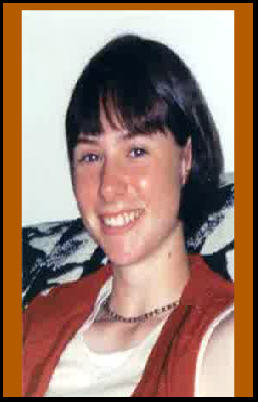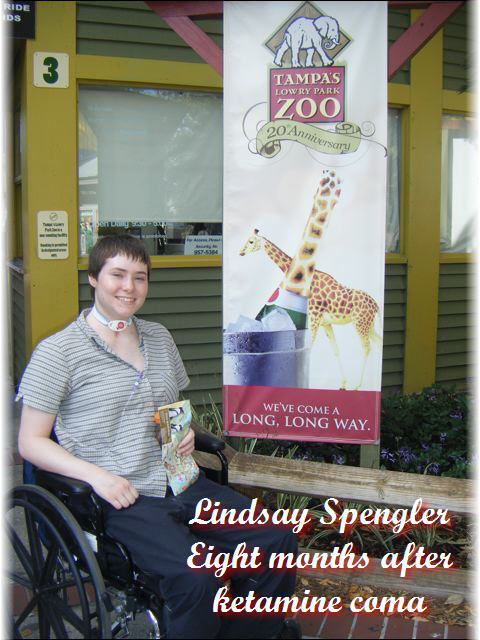 |
Dear Dr. Kirkpatrick.
Before you see and evaluate Lindsay I would like to introduce her and allow you get to know her first, through this letter. |
Lindsay's update video and pain thresholds
.......... Learn More
Lindsay has been described by her teachers, coaches and friends as “kind, sincere, passionate, energetic, athletic, very competitive and genuine. Lindsay always gives 150% to life”. These qualities have helped her navigate these last 10 years of pain and seeing her dreams slip past her one dream at a time. She still shows amazing compassion and interest in life and would rather talk to you about what is happening in your life than the pain she endures. It has taken a tremendous toll. Her life is confined to bed and four bedroom walls (except for frequent hospital visits). Over the past 10 years she has spent nearly 3 ½ years in various hospitals, to no avail. RSD was initially diagnosed in 1996,at the age of 12, after Lindsay broke her right thumb playing softball. After the cast was removed, the pain and extreme sensitivity persisted. Her doctor recommended physical therapy and desensitization techniques for several months. Her symptoms resolved and we thought all was well and back to normal.
Two years passed without any recurrence of pain. However in 1998 at the age of 14 she sprained her right ankle playing basketball. When her symptoms did not resolve RSD was once again diagnosed. This time desensitization and physical therapy took much longer and the pain was more intense. The sheets on her bed caused terrible pain, as did the water running over her ankle when she showered. Despite the pain the therapists said to keep running, walking and exercising. At this time, as a freshman, Lindsay was asked, to try out for the Senior High School Softball Team. She was determined not to let RSD ruin this opportunity. With the great disadvantage of RSD pain she pushed herself to play and earned a starting position on the Varsity Team.
A year later she sprained the same ankle but this time physical therapy, desensitization and using a TENS unit did not improve her symptoms. She was then referred to several other physicians. She was treated with multiple sympathetic nerve blocks and physical therapy. It appeared the symptoms might be improving. However this would not be the case. The pain lessened significantly but other symptoms seemed to set in, which caused much confusion in the medical arena and a cascade of treatments, hospitalizations and misdiagnosis’ over the next several years.
By the age of 17, Lindsay suffered from severe headaches and had difficulty concentrating and processing new information. She experienced severe nausea, muscle tremors/spasms, fatigue and weakness, especially on her right side. At times her right leg would collapse underneath her. The skin on her lower right leg was ice cold and often times mottled in color. The hair growth was unusually rapid and her reflexes were found to be extremely brisk. Due to the severity of her symptoms she was only able to attend 2 hours of class a day her Senior Year. The rest of her classes were taken at home with the help of tutors.
She went from a 4.0 student, to one who needed accommodations. She was deprived of attending her senior prom, class trip and playing the sport that she both excelled in and had a passion for. She was able to graduate with her classmates in the spring of 2002. That same fall at the age of 18, Lindsay’s symptoms worsened and she was again hospitalized for severe headaches and a dystonic reaction of her neck muscles that kept jerking her head to the side. The nausea worsened and she could no longer enjoy her favorite foods and would require intravenous feedings for her nutrition. Shortly after admission Lindsay went into respiratory arrest, needing a ventilator to breathe for her for many months. Lindsay remained hospitalized for 15 months and would not be discharged until January of 2004. In the course of the hospitalization the RSD diagnosis was lost.
Since that admission in the fall of 2002, she has been bedridden, unable to walk or eat, and her body hurts all the time. All of Lindsay’s friends moved on to college pursuing careers, making new friends and experiencing the independence of a normal young adult. All of this was robbed from Lindsay. Few people beyond the family visited, and TV was the only exposure to the outside world. |
The classic RSD pain returned in May of 2006, to her right ankle and rapidly spread up her leg, back and her entire right side. Lindsay explained that it feels like someone poured gasoline on her skin and lit a match. She could not tolerate bathing or have clothing or sheets touch her right side. If someone walked past her too quickly, the movement of air would cause excruciating pain and intense burning. She could tell if there was a hair or a piece of lint on her back, by the burning pain she felt. At times her skin on her back and right side would turn deep reddish purple and only a portion of her body would sweat. She could only lie on her left side.
Throughout this time she was treated with TENS units and FSM machines, narcotics, antidepressants, anticonvulsants, muscle relaxants, acupuncture, chiropractics, and herbal medicines. She has been on Lyrica, steroids, anti-inflammatories as well as clonidine patches. She has tried hypnotherapy and relaxation techniques in order to deal with the intense pain. However, excruciating burning pain remains her constant companion.
In January 2007 Lindsay was once again admitted to the hospital but this time under the care of an RSD specialist. A 7 day lidocaine infusion was tried but with no improvement. Since that time she has had several pain crisis, which seems to change the character of the pain. On 3 different occasions the pain became so severe and intense that Lindsay appeared to have passed out from the pain, unable to respond to her surroundings. In reality Lindsay was very much aware of the burning pain and what was going on around her but was paralyzed to move or make her needs known. Her stomach and lungs burn and it feels as if sandpaper were being rubbed all over her body. She will have times when her arm or hand will jerk to one side or her neck and hands seems to be in spasms causing contractions and more pain. At 23 years old Lindsay remains bed bound and confined to her bedroom unable to eat, sit up, walk, or tolerate the touch of clothing on her skin. She still receives her nutrition intravenously. Her medications are also given intravenously or through a tube in her stomach. Lindsay is unable to fly on a commercial flight and will require a ground and air ambulance for transport. Even in an air ambulance, the slightest air turbulence produces unbearable pain. But, Lindsay is willing to do what ever it takes to see you in order for the chance to experience life again. Our whole family appreciates greatly, your willingness to review Lindsay’s case. Pain and illness do affect the whole family. Hope seemed to be fading. We thank you for the chance that Lindsay may return to the life she so desperately wants to live. Our hope is that we may share that together as a family.
Thank you for that possibility.
Michael and Sharon Spengler Lindsay Spengler
|
28-minute video pre-coma evaluation 340K
7 MONTH POST-COMA VIDEO :
25-minute post-coma video 340K
24 MONTH POST-COMA VIDEO
IMPORTANT INFORMATION FOR CAREGIVERS :
20-minute post-coma video 340K
Measurement of Pain Thresholds .... Learn more
RELATED LINKS:
Immediate Post-Coma Evaluation
RSD Decreases Perception To Certain Pain
